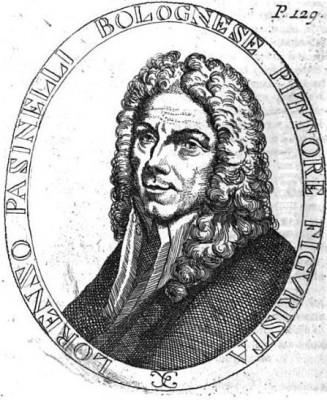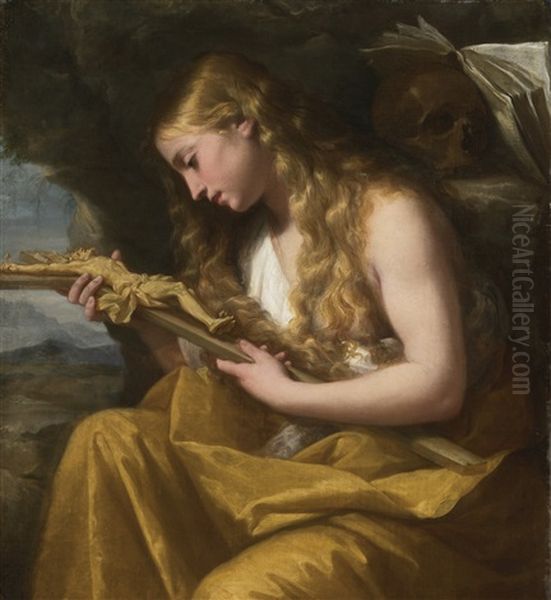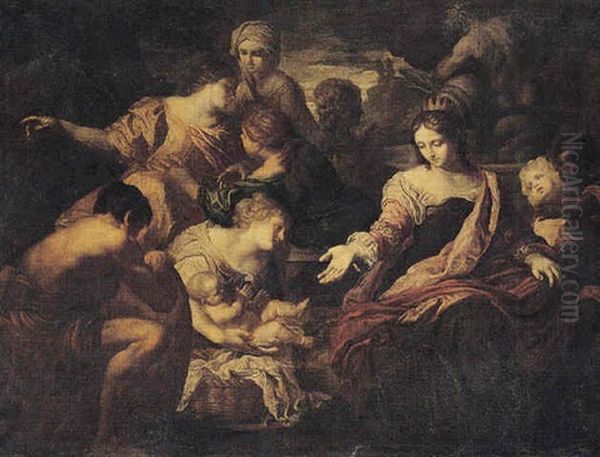
Lorenzo Pasinelli stands as a significant figure in the landscape of Italian Baroque painting, particularly within the rich artistic milieu of Bologna during the latter half of the 17th century. Born in Bologna in 1629 and passing away in the same city in 1700, his life and career unfolded entirely within this vibrant artistic center. He became renowned for his elegant style, refined colour palette, and his influential role as both a prolific artist and a respected teacher, bridging the gap between the High Baroque and the emerging Rococo sensibilities.
Early Life and Artistic Formation
Pasinelli's artistic journey began in his native Bologna, a city already steeped in a formidable artistic tradition established by the Carracci family – Annibale, Agostino, and Ludovico Carracci – and further developed by masters like Guido Reni, Domenichino, and Guercino. His initial training was under Simone Cantarini, known as "Il Pesarese," an artist noted for his Reni-influenced classicism blended with a sensitive naturalism. This early exposure likely instilled in Pasinelli a strong foundation in drawing and composition.
Following his time with Cantarini, Pasinelli entered the workshop of Flaminio Torre. Torre, another Bolognese painter, was known for a somewhat more robust and decorative style. From Torre, Pasinelli likely absorbed techniques related to dynamic composition and perhaps a bolder application of paint, though he would ultimately refine these influences into a more graceful and sophisticated manner. This period marked a crucial phase in his development, learning from two distinct artistic personalities within the Bolognese school.
The Influence of Venice and the Development of a Personal Style
A pivotal moment in Pasinelli's artistic maturation was his journey to Venice. The city, with its dazzling artistic heritage, left a profound impact on him. He was particularly captivated by the works of the 16th-century Venetian master Paolo Veronese. Veronese's grand compositions, luminous colour, and opulent textures resonated deeply with Pasinelli. However, true to his developing artistic independence, Pasinelli did not merely imitate Veronese.

Instead, he assimilated the lessons of Venetian colour and light into his existing Bolognese training. He sought to combine the compositional grandeur and chromatic richness of Veronese with the strong drawing (disegno) emphasized by the Bolognese tradition. This synthesis resulted in a distinctive personal style characterized by elegance, fluid lines, soft, almost sfumato-like modelling, and a rich, harmonious palette. He moved away from the more dramatic intensity of some earlier Baroque masters towards a more lyrical and graceful aesthetic.
A Leading Painter in Bologna
Returning to Bologna, Pasinelli established himself as one of the city's leading painters. His workshop became a hub of activity, attracting commissions and students alike. He proved versatile, adeptly handling various genres, including large-scale religious altarpieces, mythological narratives, historical subjects, and intimate portraits. His reputation grew steadily throughout the latter decades of the 17th century.
Pasinelli received numerous commissions from local churches and religious orders. His religious paintings often depicted scenes from the New Testament or the lives of saints, executed with a characteristic blend of piety and elegance. He was skilled at conveying emotion through subtle gestures and expressions, avoiding excessive melodrama while still creating engaging and moving narratives.
Notable Works and Themes
While a definitive, exhaustive catalogue can be complex, several key works and recurring themes define Pasinelli's oeuvre. His religious subjects were numerous. Works like St. Apollonia (an early work potentially dated around 1650) showcase his developing style. He frequently depicted the Penitent Magdalene, a popular Counter-Reformation subject, allowing for the portrayal of both beauty and piety.
Themes involving the young St. John the Baptist were also favoured, such as The Infant Saint John Playing with a Lamb (possibly around 1675), which allowed for a tender and charming depiction blending religious sentiment with genre-like observation. He also tackled major narrative scenes from the life of Christ, including depictions of Christ Entering Jerusalem and the Ascension of Christ, contributing to the rich tradition of Bolognese religious art. Another significant religious theme he explored was St. John the Baptist Preaching in the Desert.
Mythological and allegorical subjects provided Pasinelli ample opportunity to display his elegant figures and rich colour. Themes like Cupid and Psyche appeared in his work, reflecting the era's interest in classical mythology interpreted through a Baroque lens. Allegorical figures, such as Albunea, the Tiburtine Sibyl or The Pensive Muse (both potentially early works), allowed him to explore idealized female forms and complex symbolic meanings. A work known as Girl in a Cage further points to his interest in allegorical or genre scenes with potential underlying messages.

His skill was also recognized through reproductive prints. The Bolognese engraver Giuseppe Maria Rolli created an engraving titled The Budrio Sibyl based on a Pasinelli painting, attesting to the popularity and perceived importance of his compositions as models of allegorical representation.
The Workshop and Pasinelli's Pupils
Pasinelli was not only a successful painter but also a highly influential teacher. His studio in Bologna became a significant training ground for the next generation of artists. He passed on his refined style and technical skills, shaping the direction of Bolognese painting as it transitioned towards the 18th century. His teaching methods likely emphasized drawing, composition, and his characteristic approach to colour and light.
Among his most notable pupils was Donato Creti (1671-1749). Creti developed a highly polished, almost porcelain-like finish and a meticulous technique, often working on a smaller scale but with great precision. While clearly influenced by Pasinelli's elegance, Creti forged his own distinct, somewhat academic, late Baroque/Rococo style.
Giovanni Gioseffo dal Sole (1654-1719) was another prominent student. Dal Sole became a successful painter in his own right, known for his rich colouring and large-scale decorative works, carrying forward aspects of Pasinelli's grandeur but often with a warmer, more robust palette.
Giovanni Antonio Burrini (1656-1727) also studied with Pasinelli. Burrini developed a more dynamic and painterly style, influenced by both his master and Venetian art, working not only in Bologna but also in cities like Venice and Turin. His work often displays energetic brushwork and dramatic compositions.
Other artists who passed through Pasinelli's studio or were significantly influenced by him include Francesco Monti (known for varied subjects and vibrant colour), Aureliano Milani (who focused on anatomical study and a style recalling the Carracci), and Giuseppe Gambarini (who also studied with Cesare Gennari).
Further figures associated with his school include Giampietro Zanotti (also a writer and secretary of the Clementina Academy), Odoardo Orlandi, and Girolamo Negri (sometimes known as "il Boccia"). The painter Giovanni Viani, though perhaps more directly a student of Domenico Maria Viani, operated within the artistic circle heavily influenced by Pasinelli and the late Bolognese tradition. Through these students, Pasinelli's influence extended well into the 18th century.
Relationships with Contemporary Artists
Pasinelli's career unfolded within a competitive but also collaborative artistic environment. He maintained a significant relationship with Carlo Cignani (1628-1719), a near-exact contemporary and another leading figure in late 17th-century Bologna. Sources suggest a relationship of mutual respect and perhaps friendly rivalry. Both artists navigated the legacy of Reni and the earlier masters, developing elegant, classicizing styles, though Cignani's often possessed a cooler, more statuesque quality compared to Pasinelli's softer touch.
He would have also interacted with other prominent Bolognese artists of the time, such as Giovanni Andrea Sirani (father of the famed female artist Elisabetta Sirani), who was active in similar circles, contributing to the city's artistic output, particularly in religious commissions.
Artistic rivalries were also part of the scene. Sources mention a degree of competition with Emilio Taruffi (1633-1696), another Bolognese painter. Their differing approaches, for instance in depicting subjects like St. John the Baptist Preaching, might have spurred each other on or highlighted their distinct artistic aims, with Taruffi sometimes noted for a particularly appealing style that Pasinelli had to contend with.
Pasinelli's position was thus defined not only by his own output but also by his interactions – learning from predecessors like Cantarini and Torre, absorbing external influences like Veronese, collaborating or competing with contemporaries like Cignani and Taruffi, and shaping successors like Creti and Dal Sole.
Patronage and Recognition
Pasinelli enjoyed considerable success and recognition during his lifetime. He received commissions from important Bolognese noble families, who sought him out for portraits and decorative paintings for their palazzi. The documented relationship with Count Alessandro Fava, who purchased works like a Madonna at the Foot of the Cross, exemplifies the type of aristocratic patronage he attracted.
He was also favoured by ecclesiastical patrons. He contributed works to various churches and religious institutions in Bologna and the surrounding region. His involvement in decorative projects, such as frescoes for the Certosa di Bologna (the Carthusian monastery), underscores his high standing and ability to manage large-scale commissions. These projects placed him alongside other major artists of the Bolognese school.
His paintings were sought after by collectors both within Bologna and beyond, contributing to the dissemination of the Bolognese style. His reputation was that of a master possessing technical skill, refined taste, and the ability to create works of enduring beauty and decorum, fitting the aesthetic preferences of the late Baroque era.
Style, Legacy, and Conclusion
Lorenzo Pasinelli's artistic style is characterized by its elegance, grace, and sophisticated use of colour and light. He successfully blended the Bolognese emphasis on drawing and structured composition with the chromatic richness and painterly qualities of the Venetian school, particularly Veronese. His figures are often idealized, with smooth flesh tones, flowing drapery, and expressive, though rarely overwrought, gestures. His palette tends towards rich, harmonious colours, often bathed in a soft, diffused light that avoids harsh contrasts.
His legacy lies in his contribution to the evolution of the Bolognese school. He represented a continuation of its grand tradition but infused it with a lighter, more graceful sensibility that anticipated aspects of the Rococo. He maintained a high level of technical proficiency and artistic refinement in an era when Bolognese art was transitioning away from the powerful High Baroque of the earlier 17th century.
Furthermore, his role as a teacher was crucial. Through his influential pupils, particularly Donato Creti and Giovanni Gioseffo dal Sole, his artistic DNA was transmitted into the 18th century, ensuring the continuation of a distinct Bolognese artistic identity. He stands as a pivotal figure, embodying the elegance and technical mastery of the late Italian Baroque, and leaving a lasting mark on the art of his native city. Lorenzo Pasinelli remains an important artist for understanding the complexities and richness of Italian painting in the second half of the 17th century.